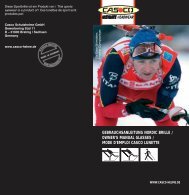You also want an ePaper? Increase the reach of your titles
YUMPU automatically turns print PDFs into web optimized ePapers that Google loves.
10<br />
11<br />
2.<br />
4.<br />
3.<br />
5.<br />
Close the buckle lock. Position the strap adjustment buckle (2)<br />
underneath your ear and tighten the chin strap by pulling on the loose end<br />
of the strap (3) until this sits com<strong>for</strong>tably under your chin. (To loosen the<br />
chin strap raise the strap adjuster unit and the end of the strap). Now<br />
close the clip lever. Carry out the same adjustment on the other side with<br />
(4) & (5). The loose ends of the straps must now be fed through the<br />
rubber O-Ring.<br />
5. Checking the fit and securing the straps<br />
Be<strong>for</strong>e you use the helmet, check that it sits correctly and that the straps are correctly adjusted and<br />
the chin strap is tight enough. Place the helmet on in the right position and close the adjustment<br />
buckle.<br />
Try to twist the helmet to the left and right with both hands. If the helmet fits you correctly, the skin<br />
of your <strong>for</strong>ehead will be moved with the helmet. If it doesn’t then the helmet is too loose. Go back to<br />
Point 2.<br />
With both hands try to pull down the helmet as far as possible at the back and the front. Make a<br />
serious ef<strong>for</strong>t. This is important. If you can tip the helmet so far <strong>for</strong>ward that it obstructs your view or<br />
so far back that your <strong>for</strong>ehead is uncovered, the helmet is not positioned correctly. Repeat Point 4<br />
until the movement of the helmet is only slight.<br />
CAUTION!<br />
If you cannot fit this helmet so that it can be tipped only slightly backwards and <strong>for</strong>wards with the<br />
straps tightened, DO NOT USE THIS HELMET! Replace it with a smaller one or another model<br />
from the <strong>CASCO</strong> range.<br />
Do a test ride<br />
If the helmet fits correctly and the straps are properly adjusted, do a short test ride. Pay attention to<br />
how the helmet sits and whether it is com<strong>for</strong>table to wear during the ride. If necessary, adjust the<br />
chin strap and other straps again to improve the com<strong>for</strong>t in wear and the position.<br />
B: REPLACING THE CLIP-IN HEAD RING<br />
If your helmet is provided with the mechanical clip-in system (red clips <strong>for</strong> head<br />
ring suspension in the helmet) you can replace the head ring, if required, by<br />
unbuttoning the plugs of the clips to remove the head ring. Hang the new head<br />
ring into the plugs with its holes and tightly button up the plugs. Important: Never<br />
remove the red clips from your helmet.<br />
C: HOW LONG WILL THE HELMET LASTØ<br />
The protective effect of a helmet is no longer guaranteed to be at its highest level if it has suffered a<br />
hard blow or fall. A helmet damaged in this way can no longer effectively protect your head from<br />
injury. There<strong>for</strong>e even if no damage is visible externally, the helmet must be replaced. The same<br />
applies if the helmet no longer fits properly. The helmet should also be replaced after several years’<br />
use without visible damage. CHECK YOUR HELMET REGULARLY FOR VISIBLE DAMAGE!<br />
D: CHANGES TO THE HELMET, CLEANING<br />
This helmet was tested in accordance with the relevant standards during batch production and was<br />
passed.<br />
Caution!<br />
Changes to the helmet, particularly the application of paint, stickers, cleaning substances, chemicals<br />
and solvents may seriously affect your helmet’s ability to protect you.<br />
D: STORAGE<br />
Let your helmet air after every use and store it in a cool dry place. High temperatures (e.g. even in<br />
direct sunlight, behind glass, in dark bags and storerooms) can do serious damage to the helmet.<br />
Uneven helmet surfaces or bubbling are signs of heat damage. These effects can occur at a<br />
temperature of 65°C or above. <strong>CASCO</strong> <strong>helmets</strong> which have the additional label of “Monocoque-<br />
Inmold” can withstand temperatures of up to 100°C.<br />
CAUTION!<br />
Do not use <strong>helmets</strong> damaged by heat!<br />
E: IMPORTANT ADVICE FOR YOUR SAFETY<br />
YOU DON’T HAVE TO RIDE FAST TO INJURE YOURSELF! Instances of serious head injuries or<br />
even fatal injuries have been recorded even at walking pace AND EVEN WITH RIDERS WHO<br />
WERE WEARING HELMETS. The protection given by a helmet depends on the circumstances of<br />
the accident and wearing a protective helmet will not always prevent a fatal accident or long-term<br />
disability.<br />
ALWAYS WEAR A HELMET WHEN RIDING A BICYCLE OR SKATING AND RIDE CAREFULLY!<br />
THE HELMET CAN ONLY PROTECT WHAT IT COVERS!<br />
Always wear your helmet in the right position. No helmet will protect the neck or uncovered parts of<br />
the head.<br />
HELMETS MUST NOT BE WORN BY CHILDREN WHEN CLIMBING OR DURING OTHER PLAY<br />
WHERE THERE IS A RISK OF STRANGULATION.<br />
CAUTION! This helmet has been specially developed <strong>for</strong> protection during riding and skating sports.<br />
It should not be used <strong>for</strong> other kinds of sport or <strong>for</strong> motorcycle riding.<br />
Please contact your local disposal company on how to dispose of your helmet.<br />
12




